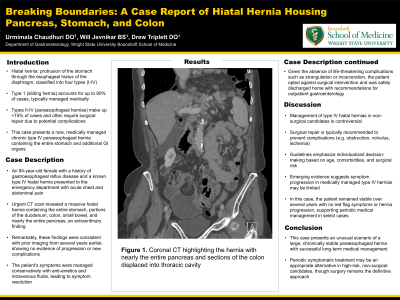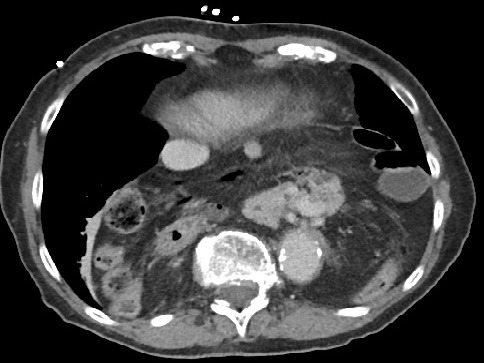Sunday Poster Session
Category: Esophagus
P0598 - Breaking Boundaries: A Case Report of Hiatal Hernia Housing Pancreas, Stomach, and Colon
Sunday, October 27, 2024
3:30 PM - 7:00 PM ET
Location: Exhibit Hall E

Has Audio

Urmimala Chaudhuri, DO
Wright State University
Centerville, OH
Presenting Author(s)
Urmimala Chaudhuri, DO1, William Jevnikar, BS2, Drew Triplett, DO3
1Wright State University, Centerville, OH; 2Wright State University Boonshoft School of Medicine, Dayton, OH; 3Wright State University, Dayton, OH
Introduction: Hiatal hernia is defined as protrusion of the stomach through the esophageal hiatus of diaphragm. They are classified into categories I-IV.1 Type I, known as the sliding hernia, accounts for up to 90% of hiatal hernia cases and are typically managed medically. Types II-IV are known as paraesophageal hernias and account for a combined less than 15% of hiatal hernia cases.1 Types II-IV hiatal hernias often require surgical repair, especially when symptomatic, due to risk of complications involving the stomach and other involved abdominal organs.2 We present a rare case of a medically managed chronic type IV paraesophageal hernia involving the entire stomach and additional segments of the GI tract.
Case Description/Methods: An 84-year-old female with a past medical history of gastroesophageal reflux disease and type IV hiatal hernia presented to the emergency department (ED) with chest and abdominal pain. Urgent abdominopelvic computed tomography (CT) revealed a large hiatal hernia containing the entire stomach, portions of the duodenum, colon, small bowel loops, and almost the entire pancreas (Figures 1,2). These imaging findings were similar in presentation to previous CT scans done several years prior. The patient’s symptoms resolved with anti-emetics and fluids, and she was discharged home from the ED with recommendations for GI follow up. The patient deferred surgical repair and hospitalization was not indicated as the patient did not exhibit signs of strangulation or incarceration of the hiatal hernia.
Discussion: Managing type IV hiatal hernias in poor surgical candidates is heavily debated. For type II-IV hiatal hernias, emergency or elective surgery is generally required to avoid life-threatening complications.3 Current guidelines suggest surgical intervention should be decided on a case-by-case basis, taking into account patient comorbidities, age, and surgical risk.4 If surgery is not pursued, recent data suggests limited progression of symptoms secondary to hiatal hernia.5,6 In our case, the patient did not have any red flag symptoms including obstruction, volvulus, or ischemia necessitating immediate surgical evaluation, and imaging comparison determined the hernia had not progressed for several years. In conclusion, surgical management is still recommended for definitive management of type IV hiatal hernias, but our case represents a rare case of a chronically stable large hiatal hernia with periodic symptomatic medical management.

Disclosures:
Urmimala Chaudhuri, DO1, William Jevnikar, BS2, Drew Triplett, DO3. P0598 - Breaking Boundaries: A Case Report of Hiatal Hernia Housing Pancreas, Stomach, and Colon, ACG 2024 Annual Scientific Meeting Abstracts. Philadelphia, PA: American College of Gastroenterology.
1Wright State University, Centerville, OH; 2Wright State University Boonshoft School of Medicine, Dayton, OH; 3Wright State University, Dayton, OH
Introduction: Hiatal hernia is defined as protrusion of the stomach through the esophageal hiatus of diaphragm. They are classified into categories I-IV.1 Type I, known as the sliding hernia, accounts for up to 90% of hiatal hernia cases and are typically managed medically. Types II-IV are known as paraesophageal hernias and account for a combined less than 15% of hiatal hernia cases.1 Types II-IV hiatal hernias often require surgical repair, especially when symptomatic, due to risk of complications involving the stomach and other involved abdominal organs.2 We present a rare case of a medically managed chronic type IV paraesophageal hernia involving the entire stomach and additional segments of the GI tract.
Case Description/Methods: An 84-year-old female with a past medical history of gastroesophageal reflux disease and type IV hiatal hernia presented to the emergency department (ED) with chest and abdominal pain. Urgent abdominopelvic computed tomography (CT) revealed a large hiatal hernia containing the entire stomach, portions of the duodenum, colon, small bowel loops, and almost the entire pancreas (Figures 1,2). These imaging findings were similar in presentation to previous CT scans done several years prior. The patient’s symptoms resolved with anti-emetics and fluids, and she was discharged home from the ED with recommendations for GI follow up. The patient deferred surgical repair and hospitalization was not indicated as the patient did not exhibit signs of strangulation or incarceration of the hiatal hernia.
Discussion: Managing type IV hiatal hernias in poor surgical candidates is heavily debated. For type II-IV hiatal hernias, emergency or elective surgery is generally required to avoid life-threatening complications.3 Current guidelines suggest surgical intervention should be decided on a case-by-case basis, taking into account patient comorbidities, age, and surgical risk.4 If surgery is not pursued, recent data suggests limited progression of symptoms secondary to hiatal hernia.5,6 In our case, the patient did not have any red flag symptoms including obstruction, volvulus, or ischemia necessitating immediate surgical evaluation, and imaging comparison determined the hernia had not progressed for several years. In conclusion, surgical management is still recommended for definitive management of type IV hiatal hernias, but our case represents a rare case of a chronically stable large hiatal hernia with periodic symptomatic medical management.

Figure: Figure 1. CT abdomen and pelvis image illustrating very large hiatal hernia containing stomach, pancreas, colon, and small bowel.
Disclosures:
Urmimala Chaudhuri indicated no relevant financial relationships.
William Jevnikar indicated no relevant financial relationships.
Drew Triplett indicated no relevant financial relationships.
Urmimala Chaudhuri, DO1, William Jevnikar, BS2, Drew Triplett, DO3. P0598 - Breaking Boundaries: A Case Report of Hiatal Hernia Housing Pancreas, Stomach, and Colon, ACG 2024 Annual Scientific Meeting Abstracts. Philadelphia, PA: American College of Gastroenterology.

